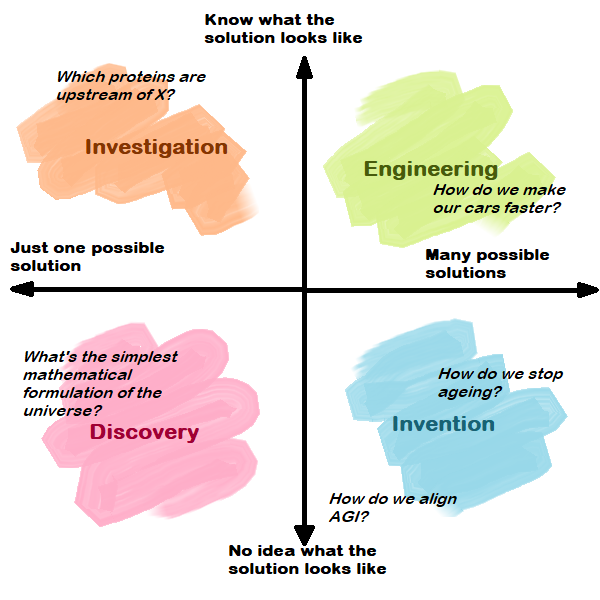A Taxonomy of Research
post by J Bostock (Jemist) · 2021-09-08T19:30:52.194Z · LW · GW · 0 commentsContents
One Solution vs Many Solutions Known Solution vs Unknown Solution The Grid None No comments
When doing research you have methods of doing things. These differ from field to field according to the sort of thing you're investigating.
You also have overarching principles which direct your attention and resources along certain lines. The latter are much more interesting to talk about.
One Solution vs Many Solutions
For some avenues of research, there is only one solution. Think discovering Newton's Laws, or finding the protein which is responsible for breakdown of proteins in the stomach. Research is therefore a process of ruling out answers until you get to the only one which is correct. This often comes down to finding the best model. Eventually it comes down to finding a model so good it's the best model possible, which is "the truth".
For others, there are many solutions. Think drug discovery, or developing a new technology. Research here is often a process of search for a decent design, followed by gradual improvement. Other times, it's coming up with a new insight as to how existing things can be used. This is more like problem solving.
Known Solution vs Unknown Solution
For some problems, the general form of the solution is likely to be known. If you're working in battery technology, you probably know the next battery will have an anode, cathode, and an electrolyte which can accept and give up electrons. If you're trying to make a new antibiotic you probably know what sort of molecule it will be.
For other problems, you might have no idea. Until they were discovered, nobody knew what the laws of quantum field theory would look like, nobody expected the world to be made out of weird functions in 4d. Research in gene sequencing has come up with lots and lots of wildly different approaches.
The Grid
Looking for a single answer that you don't know what it looks like is discovery.
Looking for a single answer that you have a pretty good idea of what it will look like is investigation.
Trying to solve a problem with a solution you know the form of is engineering.
Trying to solve a problem with a solution you don't know the form of is invention.

Depending on where you're aiming, you need different tools.
The further down, and also the further right, the more you need to pay attention to unexpectedly unexpected results. These are results which vary orthogonally to the axis of variation you're studying. Being further down and right is also (arguably) where creativity is most important.
Being further left means you need to be more specific. It's about cutting down hypothesis space. This means doing experiments with the aim to gain the very maximum information possible. If you're in the bottom left, this is especially important as your hypothesis space is largest, and the target space is smallest.
In the top left, you can usually stick to established methods. This is often where lots of data can be gathered, and then lots of numerical analysis can be carried out. This is how we get the most detailed models, like understanding not just the structure of a protein, but exactly which order the different parts of it fold in.
The top right has often been banished from scientific research altogether. That's why "engineer" is a whole job. It is, however, often how physical things get designed and made. This is why "engineers" are so well paid.
0 comments
Comments sorted by top scores.